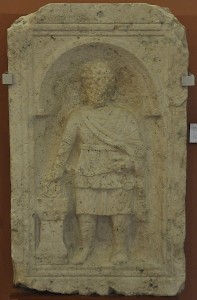G. Mucius Scaevola
Gaius Mucius Scaevola: legendary Roman hero from the early years of the Republic.

The legend of Gaius Mucius Scaevola is best known from the History of Rome from its foundation by Livy and the Roman Antiquities by Dionysius of Halicarnassus, who calls the man Cordus, "late born".note Both historians wrote during the first years of the reign of the emperor Augustus, but the story is at least a century older. The first reference is a fragment from a Roman history by the mid-second-century author Lucius Cassius Heminia.
The story's context is as follows. In the third year of the Roman republic (507 according to the Varronian chronology; 505/504 or 504/503 in the common chronology), the Etruscan king Lars Porsenna besieged Rome, hoping to bring back its last king, Tarquin the Proud. Several acts of Roman heroism (by Horatius Cocles, Cloelia, and Mucius Scaevola) convince the invader that he will never be able to capture the city, and therefore, negotiations are opened. The Romans surrender hostages but remain independent.
Before we focus on Mucius Scaevola's heroism, it must be noted that Porsenna almost certainly captured Rome (something that is admitted by another historian, Tacitus).
The story itself is that during the siege, a young Roman of noble birth, Gaius Mucius, enters the enemy camp and tries to assassinate king Porsenna. However, instead of killing him, he kills one of his secretaries. When he is brought before Porsenna, the man shows his contempt for torture and pain by voluntarily placing his right hand in a fire. Impressed by this steadfastness, Porsenna releases him, and Mucius answers to this gentle act by informing the king that there are no less than 300 men in Rome who have sworn to kill Porsenna. After his return to the city, Mucius is surnamed Scaevola ("left hand") and the Senate rewards him with a grant of land west of the river, the Mucia Prata, "Mucian Meadows".
There are several variants on this story. For example, Livy says that Mucius killed the secretary because he was better dressed than the king. Another author, Valerius Maximus, implies that Mucius' hand trembled before he had to strike. Dionysius does not mention the self-mutilation in the fire at all.
Whatever variant one prefers, the story about the conqueror of pain is extremely problematic. The first complication is that burning a right hand was the punishment of a traitor or someone who broke an oath. The original legend, therefore, dealt with someone who was punished but showed no sign of fear.
The story about the attempt to kill Porsenna is a later addition. There are several Greek parallels (e.g., the Athenian Codrus entering an enemy camp) and the presence of secretaries near the king points to a third-century date.
Another problem is that the name Gaius Mucius Scaevola is impossible. Mucii Scaevolae are known from the late third century onward, but they are always called Quintus and Publius. The first to be called Gaius is the Mucius Scaevola who occupied a minor priesthood in 17 BCE, after Dionysius and Livy published their accounts.
We are left with an intriguing story that may contain a historical element, but we cannot discern what is true and what is not.